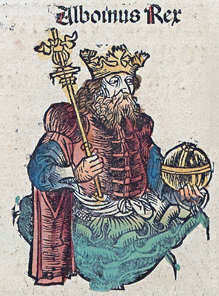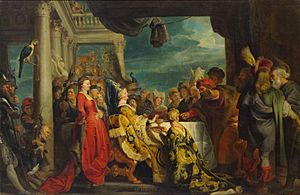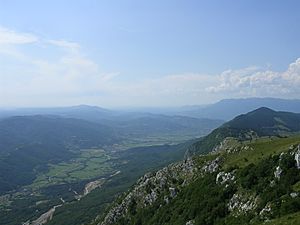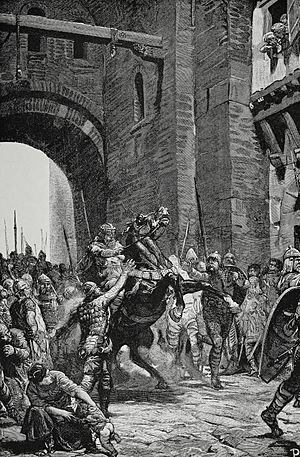Alboin facts for kids
Quick facts for kids Alboin |
|
|---|---|
| King of the Lombards | |

Woodcut vignette of Alboin in the 1493 Nuremberg Chronicle
|
|
| Reign | 560/565 – 572 |
| Predecessor | Audoin |
| Successor | Cleph |
| Born | 530s Pannonia |
| Died | 28 June 572 (Aged 42) Verona, Italy |
| Burial | Verona, Italy |
| Spouse | Chlothsind Rosamund |
| Issue | Albsuinda |
| House | Gausi |
| Father | Audoin |
| Mother | Rodelinda |
| Religion | Arianism |
Alboin (born in the 530s – died June 28, 572) was a powerful king of the Lombards. He ruled from about 560 until his death in 572. During his time as king, the Lombards stopped moving around and settled in Italy. Alboin conquered the northern part of Italy between 569 and 572.
His actions had a big impact on Italy and the Pannonian Basin. In Italy, his invasion started centuries of Lombard rule. In the Pannonian Basin, his victory over the Gepids and his departure from Pannonia ended the rule of Germanic peoples there.
Alboin's time as king in Pannonia was full of fights between the Lombards and their main rivals, the Gepids. The Gepids were stronger at first. But in 567, Alboin made an alliance with the Avars. With their help, he won a major victory against the Gepids. The Avars then took over the Gepids' lands.
However, the Avars became very powerful, which worried Alboin. So, he decided to leave Pannonia and move to Italy. He hoped to take advantage of the Byzantine Empire being weak there after the Gothic War.
Alboin gathered a large group of different peoples. In 568, he crossed the Julian Alps into Italy, which was mostly undefended. He quickly took control of most of Venetia and Liguria. In 569, he entered Milan, a major city in northern Italy, without a fight. But Pavia fought back strongly. It took three years to capture Pavia. During this time, Alboin also moved into Tuscany. However, his supporters started to disagree, and Alboin's control over his army began to weaken.
Alboin was killed on June 28, 572. This happened in a coup d'état (a sudden takeover of power) that the Byzantines helped plan. It was organized by Alboin's foster brother, Helmichis. Alboin's wife, Rosamund, also supported the plot. She was the daughter of the Gepid king whom Alboin had killed years earlier.
Most Lombards opposed the coup. They elected Cleph as Alboin's new king. Helmichis and Rosamund had to run away to Ravenna for protection from the Byzantine Empire. Alboin's death meant the Lombards lost the only leader who could keep their new kingdom together. He was the last of the hero-kings who had led the Lombards on their long journey from the Elbe river to Italy. For many centuries after his death, Alboin's bravery and success in battle were celebrated in poems.
Contents
Alboin's Early Life
The name Alboin comes from old Germanic words meaning "elf" and "friend." He was known as Alboinus in Latin.
His Father's Rule
The Lombards, led by King Wacho, had moved east into Pannonia. This happened after the Ostrogothic Kingdom in Italy faced problems when its founder, Theodoric, died in 526. When Wacho died around 540, his young son Walthari became king. But Alboin's father, Audoin, from the Gausian dynasty, ruled in Walthari's place. Seven years later, Walthari died, and Audoin became king himself.
Alboin was probably born in the 530s in Pannonia. His parents were Audoin and Rodelinda. Alboin, like his father, was raised following pagan beliefs. Alboin married Chlothsind, the daughter of the Frankish King Chlothar I. This marriage happened around 555. It showed that the Lombards were moving away from their old allies, the Byzantines.
Alboin first showed his skills in battle against the Gepids. In the Battle of Asfeld (552), he killed Turismod, the son of the Gepid king Thurisind. After this victory, Alboin visited Thurisind's court. There, the Gepid king gave him Turismod's weapons. This was a custom for young warriors to be allowed to sit at their father's table.
King in Pannonia
Alboin became king after his father died, sometime between 560 and 565. The Lombards chose their king from the previous king's family. Soon after, in 565, a new war started with the Gepids, now led by Cunimund, Thurisind's son.
The Byzantine Emperor Justin II supported the Gepids at first. He sent his son-in-law Baduarius to lead an army against Alboin. The Lombards were completely defeated.
To avoid being destroyed, Alboin made an alliance in 566 with the Avars, led by Bayan I. The Avars demanded a lot: a tenth of the Lombards' cattle and half of the war treasures. They also wanted all the Gepid lands after the war. The Lombards told the Avars that the Byzantines were allied with the Gepids. Cunimund, the Gepid king, asked the Emperor for help again. But the Byzantines were angry because the Gepids had not given them the region of Sirmium as promised. So, the Byzantines stayed neutral.
In 567, Alboin and the Avars attacked Cunimund. Alboin invaded the Gepid lands from the northwest, while Bayan attacked from the northeast. Cunimund tried to stop the two armies from joining. He fought Alboin between the Tibiscus and Danube rivers. The Gepids were defeated, and their king was killed by Alboin. Cunimund's daughter, Rosamund, was captured. The Avars then finished destroying the Gepid kingdom in the east. The Gepids stopped existing as an independent people.
Before 568, Alboin's first wife Chlothsind died. After his victory against Cunimund, Alboin married Rosamund. This was to create a bond with the remaining Gepids. This war, along with the Lombard migration the next year, marked the end of Germanic rule in the Pannonian Basin.
Moving to Italy
Even though he won against the Gepids, Alboin didn't become much stronger. He now faced a much bigger threat from the Avars. Historians believe this was the main reason Alboin decided to move. Many Lombards had seen Italy in the 550s when they fought there for the Byzantines. They knew Italy was weak after the Plague of Justinian and other problems.
The Lombards saw Italy as a rich land with many treasures. Alboin used this idea to gather a huge group of people. This group included not only Lombards but also Heruli, Suebi, Gepids, Thuringii, Bulgars, Sarmatians, some Romans, and a few Ostrogoths. The most important group, besides the Lombards, were the Saxons. About 20,000 Saxon warriors and their families joined the journey. Their involvement suggests that Alboin had the support of the Franks for his plan.
It's hard to know the exact size of Alboin's group. Estimates range from 100,000 to 300,000 people. Some historians think 150,000 is a realistic number.
Alboin made his alliance with the Avars even stronger. They signed a "perpetual treaty." The Avars would take over Pannonia. The Lombards were promised military help in Italy if needed. Also, for 200 years, the Lombards could reclaim their old lands if the plan to conquer Italy failed. This agreement protected Alboin's rear. It also made it hard for the Byzantines to send forces to Italy by land. The agreement worked very well, and relations with the Avars were friendly for a long time.
Some old stories say that Narses, a Byzantine general, invited the Lombards to Italy. He was supposedly angry about being removed from his position. Modern scholars think this might mean the Byzantine Empire formally invited the Lombards to settle in northern Italy. They might have wanted help protecting the region from the Franks.
The March to Italy
| "This Albuin led into Italy the Langobards who were invited by Narses (chief) of the secretaries. And Albuin, king of the Langobards, moved out of Pannonia in the month of April after Easter in the first indiction. In the second indiction, indeed, they began to plunder in Italy, but in the third indiction he became master of Italy." |
| The Origin of the Nation of the Langobards, Chapter V |
The Lombard migration began on Easter Monday, April 2, 568. Alboin had recently converted to Arian Christianity. This conversion was likely for political reasons. It helped unite the migrants and set them apart from the Catholic Romans. It also connected Alboin to the Goths, hoping to get support from Ostrogoths in the Byzantine army.
The Lombards usually waited until autumn to start migrations. But they left in spring, perhaps because they were worried about the Avars. Alboin also decided to destroy Pannonia. This created a safe zone between the Lombards and the Avars.
Historians disagree on the exact path Alboin took to Italy and how long it took. The Lombards likely split into groups. A vanguard (front group) scouted the way, probably following a route through Poetovio, Celeia, Emona, and Forum Iulii. The wagons and most people moved slowly behind. By September, raiding parties were looting Venetia. It was probably in 569 that they crossed the Julian Alps at the Vipava Valley.
Invasion of Italy
Starting the Duchy of Friuli
| "When Alboin without any hindrance had thence entered the territories of Venetia [...] – that is, the limits of the city or rather of the fortress of Forum Julii (Cividale) – he began to consider to whom he should especially commit the first of the provinces that he had taken. [...] he determined [...] to put over the city of Forum Julii and over its whole district, his nephew Gisulf [...] This Gisulf announced that he would not first undertake the government of the city and people unless Alboin would give him the "faras", that is, the families or stocks of the Langobards that he himself wished to choose. And this was done" |
| Paul the Deacon Historia Langobardorum, Book II, Ch. 9 |
The Lombards entered Italy without facing any resistance from border troops. The Byzantine army there was small and not very loyal. The border forts might have been empty. Archeological digs show no signs of fighting in the areas explored. This matches old stories that say the Lombards took over Friuli "without any hindrance."
The first town to fall was Forum Iulii (Cividale del Friuli). Alboin chose this walled town near the border to be the capital of the Duchy of Friuli. He made his nephew, Gisulf, the duke of the region. Gisulf's job was to defend the borders from attacks from the east. Gisulf was allowed to choose which farae (clans) would live in his duchy.
Alboin's decision to create a duchy and name a duke was new for the Lombards. Before this, they didn't have dukes or duchies based in walled towns. This was Alboin borrowing ideas from Roman and Ostrogothic ways of ruling. Choosing a fortified town as the center of the new duchy was also a big change. Before, the Lombards ignored cities, but now many nobles settled in Forum Iulii. This pattern was repeated in other Lombard duchies.
Capturing Milan
From Forum Iulii, Alboin went to Aquileia. This was an important road junction and the main city of Venetia. The people of Aquileia were very worried. The Patriarch of Aquileia Paulinus fled with his clergy and followers to the island of Grado, which was controlled by the Byzantines.
From Aquileia, Alboin followed the Via Postumia through Venetia. He quickly took Tarvisium (Treviso), Vicentia (Vicenza), Verona, Brixia (Brescia), and Bergomum (Bergamo). The Lombards only had trouble with Opitergium (Oderzo), which Alboin decided to avoid. He also avoided major coastal towns like Altinum, Patavium (Padova), and Cremona. The invasion of Venetia caused many people to flee from the Lombard-controlled areas to the Byzantine coast. This led to new settlements like Torcello.
Alboin moved west, invading Liguria (north-west Italy). He reached its capital, Mediolanum (Milan), on September 3, 569. He found it already abandoned by the Byzantine governor. The Archbishop Honoratus and many people had fled to the Byzantine port of Genua (Genoa). Alboin started counting his reign from the capture of Milan. He took the title of dominus Italiae (Lord of Italy). His success meant the Byzantine defenses in northern Italy collapsed. Many refugees moved to Byzantine areas.
Historians have different ideas about why the Lombards advanced so quickly. Some think the Goths helping the Byzantine army might have betrayed the cities. But most historians believe the Byzantines didn't see Italy as a vital part of their empire. Especially since the empire was under attack from Avars and Slavs in the Balkans and Sassanids in the east. The Byzantines decided not to fight the Lombard invasion. They wanted to focus their efforts on the eastern parts of their empire.
Impact on Italy
The Lombard invasion greatly changed the lives of the wealthy Roman families. Many lost their lives or their property. The clergy (church leaders) were also deeply affected. The Lombards were mostly pagans and didn't respect church property. Many churchmen left their cities to escape the Lombards. However, most bishops in the north tried to make peace with the Lombards. For example, the bishop of Tarvisium, Felix, met with Alboin in 569. He got Alboin to respect the Church and its property. Many bishoprics (areas led by a bishop) continued to exist through the invasion. This transition was made easier by the fact that many northern Italian bishops were already unhappy with the Pope and the Empire due to a religious disagreement. In Lombard territory, churchmen were safe from imperial religious persecution.
Some historians believe the Lombard migration was a disaster for the Church, as many bishoprics disappeared. However, other historians think the areas directly taken by Alboin suffered less damage. Towns there survived better. But areas taken by independent warrior groups, who were mainly interested in raiding, suffered more.
Siege of Pavia
The first strong resistance to Alboin's invasion happened at Ticinum (Pavia). He began to besiege it in 569, but it took three years to capture. Pavia was very important because it was at the meeting point of the Po and Ticino rivers. It was also connected by water to Ravenna, the capital of Byzantine Italy. When Pavia fell, it cut off direct communication between Byzantine garrisons.
To keep up his attack against the Byzantines, Alboin took their last defenses in northern Italy by 570. Only coastal areas of Liguria and Venetia, and a few isolated inland centers, remained. During Alboin's rule, the Lombards also crossed the Apennines and raided Tuscia. However, historians are not sure if Alboin led these raids or if they were more than just raids. Some believe Tuscany was conquered later, but others think it started under Alboin.
Alboin had more trouble controlling his people during the siege of Pavia. The Lombard monarchy was not as strong as other kingdoms. The military commanders, or duces, who led each group of warriors, had a lot of power. Also, Alboin had trouble building a strong kingdom because he didn't have the same official recognition from the Empire that the Ostrogoths had. The Lombards had entered Italy as enemies, not as allies.
The king's weakening power also showed in the invasion of Frankish Burgundy. From 569 or 570, there were yearly large-scale raids. These attacks were eventually stopped. These attacks had lasting political effects. They made Lombard-Frankish relations bad and led to an alliance between the Byzantine Empire and the Franks against the Lombards. Historians generally think Alboin was not behind these raids.
The weakening of royal power might also have led to the conquest of much of southern Italy by the Lombards. Modern scholars believe Alboin played no part in this. It probably happened in 570 or 571, led by individual warlords.
Alboin's Assassination
Early Stories
| "When his wife Chlotsinda died, Albin married another wife whose father he had killed a short time before. For this reason the woman always hated her husband and awaited an opportunity to avenge the wrong done her father, and so it happened that she fell in love with one of the household slaves and poisoned her husband. When he died she went off with the slave but they were overtaken and put to death together." |
| Gregory of Tours Historia Francorum, Book II, Ch. 41 |
Pavia finally fell to the Lombards in May or June 572. Alboin had chosen Verona as his main city. He set up his royal palace and treasury there, perhaps to connect himself with the Gothic king Theodoric.
It was in this palace that Alboin was killed on June 28, 572. The most detailed story of Alboin's death comes from Paul the Deacon. An earlier, shorter story is from Marius of Aventicum in his Chronica, written about ten years after Alboin's murder. According to Marius, the king was killed in a plot by a close man named Hilmegis, with the queen's help. Helmichis then married the widow. But they were forced to escape to Byzantine Ravenna, taking the royal treasure and part of the army. This suggests the Byzantine Empire was involved.
Another story is from Gregory of Tours in his Historia Francorum. Gregory says Alboin married the daughter of a man he had killed. She waited for a chance to get revenge and eventually poisoned him. She had fallen in love with one of her husband's servants. After the murder, she tried to escape with him, but they were caught and killed. However, historians don't trust this story much.
The Skull Cup Story

Paul the Deacon's story also includes a famous detail: the skull cup. In Paul's account, Alboin held a feast in Verona. He made his wife Rosamund drink from a cup made from her father Cunimund's skull. This act deeply shamed and angered the queen, making her even more determined to get revenge for her father's death.
Paul claimed he saw this skull cup himself in the 740s in the royal palace of Pavia. Drinking from an enemy's skull was a custom among some nomadic peoples, including the Avars. It was seen as a way to take the dead man's power. For Rosamund, being forced to drink from her father's skull was a great humiliation and a sign of her complete submission to the Lombards. This act fueled her desire for revenge.
Alboin's Death
Rosamund found an ally in Helmichis, the king's foster brother. They planned to kill Alboin. When Alboin went for his midday rest on June 28, they made sure the door was left open and unguarded. Alboin's sword was also removed, leaving him defenseless. Then, a man named Peredeo entered his room and killed him. Alboin's body was supposedly buried under the palace steps.
Alboin's death had a lasting impact. It meant the Lombards lost the only leader who could keep their new kingdom together. His death also marked the end of the line of hero-kings who had led the Lombards on their long migrations. His fame lived on for many centuries in epic poems. Saxons and Bavarians celebrated his bravery in battle and his heroism.
What Happened Next
| "Helmegis then, upon the death of his king, attempted to usurp his kingdom, but he could not at all do this, because the Langobards, grieving greatly for the king's death, strove to make way with him. And straightway Rosemund sent word to Longinus, prefect of Ravenna, that he should quickly send a ship to fetch them. Longinus, delighted by such a message, speedily sent a ship in which Helmegis with Rosemund his wife embarked, fleeing at night." |
| Paul the Deacon Historia Langobardorum, Book II, Ch. 29 |
To complete the takeover and make his claim to the throne legal, Helmichis married Rosamund. Her high status as the king's widow and a Gepid leader helped ensure the Gepids' loyalty to Helmichis. He also had the support of the Lombard soldiers in Verona. Many of them might have disagreed with Alboin's aggressive policies. The Byzantines were almost certainly involved in the plot. They wanted to stop the Lombard advance and perhaps break up the Lombard kingdom.
However, the coup failed. Most of the Lombard warriors opposed the king's murder. So, the Lombard soldiers in Pavia chose Duke Cleph as the new king. Helmichis, instead of fighting, escaped to Ravenna with help from a Byzantine official named Longinus. He took his wife, his troops, the royal treasure, and Alboin's daughter Albsuinda with him. In Ravenna, Helmichis and Rosamund became enemies and killed each other. Longinus then sent Albsuinda and the treasure to Constantinople.
Cleph ruled for only 18 months before a slave killed him. He might also have been killed because the Byzantines wanted to prevent a strong Lombard leader. After Cleph's death, no new king was chosen for ten years. This time was called the Rule of the Dukes. It made the Lombards more vulnerable to attacks from the Franks and Byzantines. It was only when they faced the danger of being destroyed by the Franks in 584 that the dukes elected a new king. This was Authari, Cleph's son. He began to truly unite and centralize the Lombard kingdom. Meanwhile, the remaining Byzantine territories in Italy were reorganized under an exarch in Ravenna.
The establishment of Byzantine and Lombard territories had long-lasting effects on Italy. The region was divided among different rulers until Italian unification in 1871.
See also
 In Spanish: Alboino para niños
In Spanish: Alboino para niños
- List of kings of the Lombards





